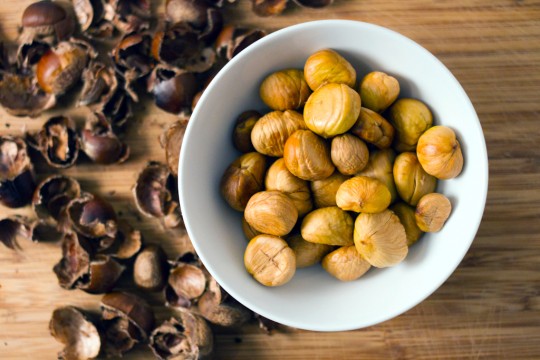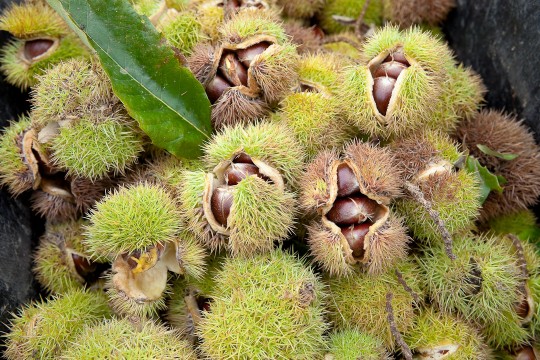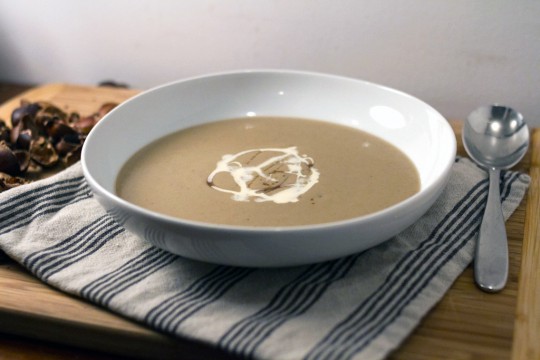
For a food with song lyrics about it ingrained in so many memories, it’s amazing to me how few people I know have actually eaten chestnuts, let alone roasted them and watched them pop (an activity I don’t recommend, but I’ll come back to that). Admit it, you can already hear Nat King Cole singing “chestnuts roasting on an open fire…” or perhaps The Andrews Sisters singing, “at the fireplace while we watch the chestnuts pop!” – that’s my favorite version anyway.
A little internet sleuthing about why this may be lead me to read about the blight imported from Asia that wiped out the the entire population of chestnut trees from Maine to the Florida panhandles in the early 1900’s. This would be the reason, I suppose, why every recipe I read calls for chestnuts from a jar, and we only sing about roasting them over an open fire.
Coming across fresh chestnuts in a farmers’ market is like spotting an opossum in Central Park. By all rights, they shouldn’t be anywhere near New York. But there they are, as real as pigeons.
– From “The Faint Taste Of a Lost Harvest: Native Chestnuts“, NY Times 2000

Here we are in 2011 and I do indeed come across chestnuts at the Greenmarket. For a brief but glorious few weeks earlier this Fall, Ray Bradley harvested and brought them to us here in Brooklyn. I actually began cooking with fresh chestnuts a few years back (they’re available at our Food Coop and non-imported ones often appear during the holiday season), but I had my mind blown the first time I saw Ray wearing gloves and prying the things from their sharp!, spiny outer cupules. I couldn’t believe these nuts that already require so much effort to remove from their inedible hard shells come with another layer of protection. And yet, somehow this knowledge just makes them all the more special to me.

How To Roast Chestnuts:
Find the flat side of the chestnuts and score them using a sharp knife, all the way through the shell in an X formation. On a baking sheet, roast the chestnuts in the oven at 425 degrees for about 15-20 minutes (if some of them haven’t split open, you can return them to the oven for a bit more time).
Remove them from the oven and wrap in a towel to steam. When they’re cool enough to handle – but don’t wait too long or they’ll be difficult – remove the husks and peel the dark brown skin. The chestnuts should be golden brown, tender and absolutely delicious.
We ate some chestnuts when they arrived at the market in late September, and I threw the rest in the freezer. If you’re lucky enough to find fresh chestnuts, they keep wonderfully this way until you’re ready to roast and eat them. I’ve been thinking about them lately as Thanksgiving approaches – aside from ‘sausage and cornbread’, ‘mushroom and chestnut’ is my second favorite turkey stuffing combination. However, when I recently returned home from a local farm event with several pounds of apples, I thought that the perfect tribute would be a chestnut and apple soup.

I’m not usually the type of person to make rich soups that start with butter and end with cream. If I cooked that way at home all the time, what would be the fun in restauranting? And my goodness, can you imagine how fat my butt would be? But like I said, I think chestnuts are special. And once you’ve roasted them, and peeled them, you might as well go the distance.

Roasted Chestnut and Apple Soup
Makes 4-6 servings
- 2 tablespoons butter
- 1 onion, chopped
- 3 stalks celery, chopped
- 4 large sage leaves, torn into bits
- 1 teaspoon allspice
- 1 lb. chestnuts (about 3 cups whole), roasted and peeled
- 1 lb. apples, peeled, cored and coarsely chopped
- 5-6 cups stock or water (I like a half and half combination)
- salt and pepper
- 3 tablespoons heavy cream
- Maple syrup for serving
In a heavy stock pot, melt the butter over a medium heat and add the onions, celery and sage. Cook until tender, stirring occasionally, about 8-10 minutes. Add the allspice, apples and chestnuts and stir to coat, cooking for a minute more. Cover with 5 cups stock/water and bring the mixture to a boil, then reduce to medium and allow to simmer for about 20 minutes or until the chestnuts and vegetables are tender enough to mash against the side of the pot.
Puree the soup and add more liquid as needed for the desired consistency (it may be quite thick). Taste and season with salt and pepper, then push the soup through a mesh sieve to catch any stubborn bits of firm chestnut. This will produce a nice silky consistency. Reheat gently as needed and stir in cream. Serve with a drizzle of maple syrup.
If you make this soup ahead of time, wait to add the cream until you reheat to serve.
If you can’t find fresh chestnuts, jar peeled cooked whole chestnuts can be substituted.
So about that popping…
It’s important to score the chestnut husks so they split open instead of popping when they roast. I did this, but I guess I didn’t score a few of them well enough. About 10 minutes in the first one POPPED! and Francine went absolutely insane. It’s sort of like someone firing a gun inside of your oven, the nearly simultaneous popping and then ricocheting of the nut as it catapults from its husk. It happened about 4 times within a few minutes, only causing Francine to grow more and more alarmed that we were most certainly under attack.
Now, barking dogs aside, why would anyone consider it a fun family pastime to sit around and watch the chestnuts pop?




Daughter Fish says:
One of my favorite things about Paris in the fall and winter are the chestnut vendors roasting these little gems on the street, the smoke wafting all around. I’ve never had the courage to roast them at home, but I am the type, when making soup, to start with a lot of butter and end with at least a little cream. I’m tryin’ this one! The pics are beautiful, btw.
Heather says:
Yes! And since you already know the magic of chestnuts, I should recommend you roast more than the recipe calls for. Brad and I have a very hard time not popping those suckers right into our mouths as we’re peeling them to cook with :)